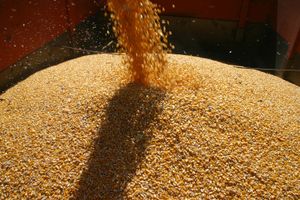Does the Corn/Wheat Ratio Offer a Clue?
 I know grains are still a long way from being described as anything close to bullish, but I have to say how refreshing it was to finally see a change this week in the dark bearish conversation that has been dominating ag markets since early March. The seeds of Thursday’s higher closes in grains were first planted Tuesday afternoon when President Donald Trump issued an executive order to reopen meat-processing plants and was further helped by bullish hints of people driving more in Wednesday’s inventory report from the Department of Energy.
I know grains are still a long way from being described as anything close to bullish, but I have to say how refreshing it was to finally see a change this week in the dark bearish conversation that has been dominating ag markets since early March. The seeds of Thursday’s higher closes in grains were first planted Tuesday afternoon when President Donald Trump issued an executive order to reopen meat-processing plants and was further helped by bullish hints of people driving more in Wednesday’s inventory report from the Department of Energy.
Coronavirus-related problems are not over and there will likely be stumbles ahead. But these small, yet important, changes put bearish traders on their heels Thursday and may well be part of a bottoming process this market appears to be experiencing.
Along those same lines, there are two commodities that have traveled drastically different paths the past nine months. Last July, DTN’s National Corn Index of cash prices peaked near $4.45 a bushel and was the king of the grain sector as concerns ran high that corn acres were being lost to the excessive spring rains of 2019.
Compared to DTN’s National soft red winter (SRW) Wheat Index, corn prices were the stronger of the two, representing 83% of the wheat price. At that time, wheat prices were weighed down by concerns of record world wheat production in 2020.
The comparison can be interesting in that grains and most other commodities have shown high correlations over the past 20 years. In the case of corn and SRW wheat, it is not much of a stretch to understand that both grains are weather sensitive and are used, at times, as substitute sources of feed demand. A study I performed from 1997 to mid-2017 showed spot corn futures and spot Chicago wheat futures (the futures version of SRW wheat) had a correlation coefficient of 89% — a strong sharing of similar market influences.
To say that corn and SRW wheat highly correlate does not mean their prices always go the same direction. Corn and SRW wheat also have their differences, and those differences drove prices in different directions the past several months.
Comparing the two prices by dividing DTN’s National Corn Index by DTN’s National SRW Wheat Index gives us the ratio that shows a relatively stable pattern of sideways fluctuation over time. Since 2000, the price of corn has often traded between 60% and 90% of the price of cash SRW wheat. There have been times when the ratio exceeded those boundaries, but usually not for long.
Unlike July of 2019, when corn traded at 83% of the wheat price, DTN’s National Corn Index closed Thursday evening (April 30) at 57% of wheat’s price. Not only is the DTN National Corn Index historically cheap at Thursday’s close of $2.87 a bushel, it is also cheap in relation to SRW wheat.
I can’t guarantee corn prices won’t go lower or that SRW wheat won’t go higher, but given the long-term relationship between these two, there is good reason to believe that corn prices are apt to gain on SRW wheat prices in the year ahead. A corn price at roughly 75% of the SRW wheat price would be more in line with their usual valuations.
From a fundamental view, both also appear to be due for a change. SRW wheat prices enjoyed bullish support in late 2019 and early 2020 with help from USDA estimating that ending SRW wheat stocks will be at their lowest level since 2013.
As we head into May, traders are looking forward to a new crop season and are more focused on the prospects for world wheat production in 2020. Previous concerns about tight old-crop stocks have lost their shine as traders start to show more interest in the size of the 2020 crop.
In the case of corn, the bearish story of early 2020 is well known by now. Efforts to limit the spread of the coronavirus brought a sharp drop in fuel consumption, and ethanol production has had to make severe cuts. Meat processing plants started closing around Easter and concerns about future feed demand increased.
DTN’s national index of cash corn prices is currently trading among the lowest prices seen in 13 years and the current situation is the worst threat to corn demand that I can recall in a 35-year career. As I said, I can’t guarantee corn prices won’t go lower.
However, this week’s changes in the bearish conversation mentioned above give a glimmer of hope that the bearish sentiment surrounding corn prices may be ready to lighten. Whether we look at corn prices by themselves or in relation to SRW wheat, it is clear extreme levels have been reached. The only question now is: how long will the extremes be sustained?
Comments above are for educational purposes and are not meant to be specific trade recommendations. The buying and selling of grain and grain futures involve substantial risk and are not suitable for everyone.
Todd Hultman can be reached at Todd.Hultman@dtn.com
Follow him on Twitter @ToddHultman
Source: Todd Hultman, DTN
